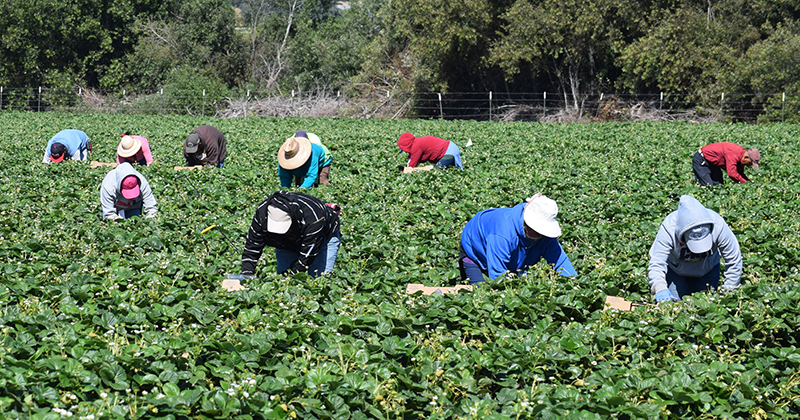One college on an awareness drive around labour exploitation was amazed at how many learners were being mistreated. Jess Staufenberg reports
“It was coming up to Christmas time and my work just stopped and I really needed money. Then one morning, he came and knocked on my door. He said, ‘I can give you good money, and good accommodation, don’t worry. Everything will be alright.’”
Raitis Darzins, who is 35, came to England to pick strawberries. He has a skills background in construction and mechanics, and while staying in Birmingham he found himself offered roofing work. “For me, it was like gold stars in my eyes. Big mistake.”
The man took Darzins to an isolated caravan. There was only a cold shower, no safety equipment to carry out the roof work, and Darzins got just £20 a day to work from 8am until 6pm.
“Every day I am hungry, hungry, hungry,” he tells me. “But I can’t say anything because I am thinking, he’s British and I’m an immigrant.”
In 2020, 10,600 referrals for modern slavery were made to the government. Of these, referrals of adults accounted for 48 per cent, with the rest – unbelievably – referrals for potential child victims.
The scandal was increasingly raised during Theresa May’s stint as home secretary, first through the Modern Slavery Act in 2015 and then when, as prime minister, May called it “the great human rights issue of our time”. Since the act, referrals have shot up, regularly increasing by a third or more year-on-year.
Workers with English as a second language are particularly at risk, with Albanian and Vietnamese nationals the second and third most likely to be referred. But UK citizens make up the largest nationality group for referrals, at 34 per cent.
“One night I escaped,” continues Darzins. “I lived in a tent in Birmingham for three or four months. It was better to be a homeless man than to be trafficked.” The man who exploited Darzins was never prosecuted, as far as he is aware.
It was better to be a homeless man than to be trafficked
Now experts on the frontline of tackling modern slavery, and other forms of labour exploitation, have turned their sights to further education as a crucial battleground against abusive practices.
Alison Gardner, who is associate director at the Rights Lab at the University of Nottingham and is leading the world’s biggest team of modern slavery researchers, explains why the sector is fundamental to enabling long-term change.
“Many of the students served by the FE sector tend to be those who are going into riskier professions, where there can be less regulation, wages are already low, and a lack of unionisation.”
Risk sectors include construction, personal and social care, health and beauty, agriculture, catering, tourism, factory work and events. Car washes and garment factories, as seen in Leicester, have also been exposed as hotbeds for exploitation.

But the type of work matters more than the sector – low paid, low skill, high demand and short term – meaning agencies and temporary work are a key concern. Gardner has seen an uptick in workers employed by agencies, who are not always passed their full wage.
“There may be deductions from pay packets, unreasonable payments for travel and expenses, or for accommodation.”
Such labour exploitation could be modern slavery – defined by government as the “recruitment, movement, harbouring or receiving of children, women or men through the use of force, coercion, abuse of vulnerability, deception or other means for the purpose of exploitation” – or could include “poor and illegal practices” that don’t clearly meet the threshold for modern slavery, explains Gardner.
This includes deducting pay, not paying into a pension or national insurance, not putting employees on the right contract or no contract at all. The area is particularly grey where someone is on an exploitative zero-hours contract but is ‘choosing’ to take on that work.
The employer may even be doing everything right, but the worker is under the control of someone else, or another agency – which is why employers checking their supply chains is so important.
“There’s not a clear dividing line on modern slavery,” says Gardner. “But FE students and the courses they’re pursuing can be much more vulnerable to it.”
There’s not a clear dividing line on modern slavery
The hard-to-spot nature of labour exploitation makes it all the more important that colleges know the signs.
Frank Hanson is a former equality and diversity manager at Boston College in Lincolnshire, who is now head of prevention and partnerships at the Gangmasters and Labour Abuse Authority (GLAA), the government’s investigative agency for labour exploitation.
He contacted his old college, whose community includes many migrant workers, to propose a pilot in labour exploitation awareness last year. “Colleges know their local economy really well, which can help build community resilience,” he says.
Boston College, where a fifth of learners have English as a second language, agreed to deliver training on labour exploitation to 200 staff.
Kaley Boothby, teaching and learning coach, said staff were “quite surprised” by what they learnt. “They weren’t really aware. It wasn’t at the forefront of their minds at all.”
More alarming was when the college went on to pilot a new qualification with learners, from January last year – a level 1 in workers’ rights and labour exploitation, developed with the GLAA by awarding organisation Skills & Education Group.
In classes of about 15 learners (across plumbing, hairdressing and health and social care) on average four students would report experiencing exploitative practices or knowing someone who had done so, says Boothby.
“Learners quite frequently weren’t getting paid properly, were paid under the minimum wage or weren’t being treated well,” says Boothby.

The college delivered the ten-hour course in tutorials (nationwide it was piloted to 351 learners). Zac Lumley, a 17-year-old level 2 plumbing student, says he would rather labour exploitation was taught in college than left to students to find out about it.
“When you come from school, you don’t really know anything. You might need to get a part-time job, but you might get taken advantage of.”
He also learned to spot warning signs. “It told us about how people might be quiet and not mix with others if they’re exposed to things like that. It opens your eyes that people might need your help or support.”
According to an impact assessment of the qualification by Gardner’s team at Nottingham University, the percentage of learners who said they “knew a lot” about recognising labour exploitation rose from 15 per cent to 47 per cent following the course.
In one case, a student took the learning materials home to show his father, because he was worried he was being exploited, according to Kaye Jackson, head of relationship management at Skills and Education Group.

Another FE provider taking it seriously is Route2Work College for learners with special educational needs in south Tyneside. Last year staff delivered lessons around workers’ rights and labour exploitation in employability sessions on Tuesdays.
“We did it because we know these learners can be more at risk and more vulnerable to labour exploitation,” says Georgia Smith, learning and standards project officer, who created a booklet for learners. Students can at first be “uncomfortable” about the tough message. “It’s just about being clear that it does go on.”
Smith is right to do so: learners with learning disabilities particularly worry Gardner, back at the Rights Lab. They are especially at risk of financial exploitation, but “currently there’s almost no consistent reporting of cognitive impairments among those people found to be exploited”.
Her team has now run a study with Nottingham City Council, due to be published soon, which found individuals with a cognitive diagnosis such as a learning disability, autism, memory loss or poor mental health, make up one-third of previously exploited people.
FE providers and employers should also check their own supply chains, urges Louise Gore, manager of the Equiano project, which supports survivors of modern slavery through Birmingham-based charity Jericho.
The charity runs a series of real businesses, and so rescues modern slavery survivors and gives them legitimate work instead.
“It’s really important organisations do everything in their power to eradicate modern slavery from their supply chains,” she says. “We know agencies who use agencies who use agencies, and the further down the line it gets, the harder it is to spot.”

If providers are concerned about something in their supply chain, or even a job advert, they can report it to the GLAA.
One employer taking the issue seriously is Kier Group, according to Gore. The construction and infrastructure firm, which has 12,000 employees – not including its supply chains – decided to train its 350 volunteer mental health ‘first aiders’ in modern slavery, so they could spot tell-tale signs while on worksites.
Doing an audit of suppliers from afar without being on the ground is not enough, says Sheryl Moore, social sustainability manager.
“It is a kind of abuse, these are people under duress, so the signs of struggling with mental health could be similar,” says Moore. “So that’s why it’s so good to train up the mental health first aiders in this. They can ask, are you alright? Are you really alright?”
All in all, it seems extraordinary that only a handful of colleges are switched on to the topic: FE Week reached out to five other colleges in areas with high-profile stories of modern slavery, but was told that no one led on the issue.
The Independent Anti-Slavery Commissioner’s office, set up with the 2015 act and led by Dame Sara Thornton, sees FE as a key player.
“Access to education can be a crucial part of a survivor’s recovery journey,” Thornton writes in this year’s annual report. But “survivors continue to face significant barriers to accessing […] further education courses”, with Brexit having the “potential to exacerbate these issues further”.
Thankfully, Darzins now has settled status. I ask him what he would like to do next. “I want to go back to college. My certificate is not English and I want to fix cars. I want to go to college.”

















Do t level work placements fall into this category
….being forced to work for nothing certainly sounds like it!!